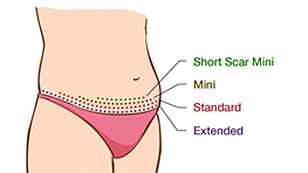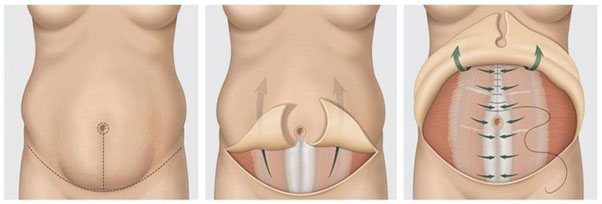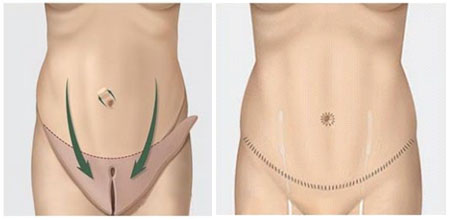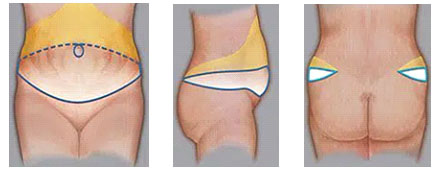There are many variations both to the design of the incisions and the technique itself. In some instances, it may be possible to avoid an incision around the navel. When the amount of loose skin is minimal and the excess fat deposits are located below the navel, a short horizontal incision is all that is necessary. This procedure is called a partial, or “mini,” abdominoplasty. Sometimes liposuction may be used alone, or in conjunction with abdominoplasty, to remove abdominal fat. Your plastic surgeon will discuss with you the particular method that he or she recommends for achieving the best result in your particular case.
The Surgery technique

Types of abdominoplasty incisions
A standard abdominoplasty usually takes two to three hours, depending on the extent of work required. Partial abdominoplasty may take an hour or two.
Initially the surgeon will make an incision just above the pubic area. A second incision is frequently made to free the navel from surrounding tissue. Next, the surgeon separates the skin from the abdominal wall all the way up to your ribs and lifts a large skin flap to reveal the vertical muscles in your abdomen. These muscles are tightened by pulling them close together and stitching them into their new position. This provides a firmer abdominal wall and narrows the waistline.

The skin flap is then stretched down and the extra skin is removed. A new hole is cut for your navel, which is then stitched in place. Finally, the incisions will be stitched, dressings will be applied, and a temporary tube may be inserted to drain excess fluid from the surgical site. In partial abdominoplasty, the skin is separated only between the incision line and the navel.

Extended abdominoplasty
This procedure is basically a standard abdominoplasty with the addition of recontouring of the hips, flanks and even the lateral thigh. Sometimes, there is significant excess skin of the hips extending onto the flanks, with ptosis (sagging) of the lateral (outer) thighs. This is usually the case after significant weight loss. In this case, a standard abdominoplasty will not address the skin excess over the hips. While a standard abdominoplasty will re-contour the central ninety percent or so of the abdomen, in these patients there will actually be an accentuation of the excess skin on the sides when the abdominal skin is advanced downward, creating a deformity which the lay public have termed a “muffin top”. The treatment is simply to adequately remove this additional excess skin through an extended abdominopasty.

Extended abdominoplasty
Mini (partial) abdmominoplasty
With the mini abdominoplasty, the main focus is on the lower abdomen. The incision is much shorter and the navel has no umbilical incision. In partial abdominoplasty, the skin is separated only between the incision line and the navel. Any weakness in the muscles of the abdomen is fully repaired (tightened).








